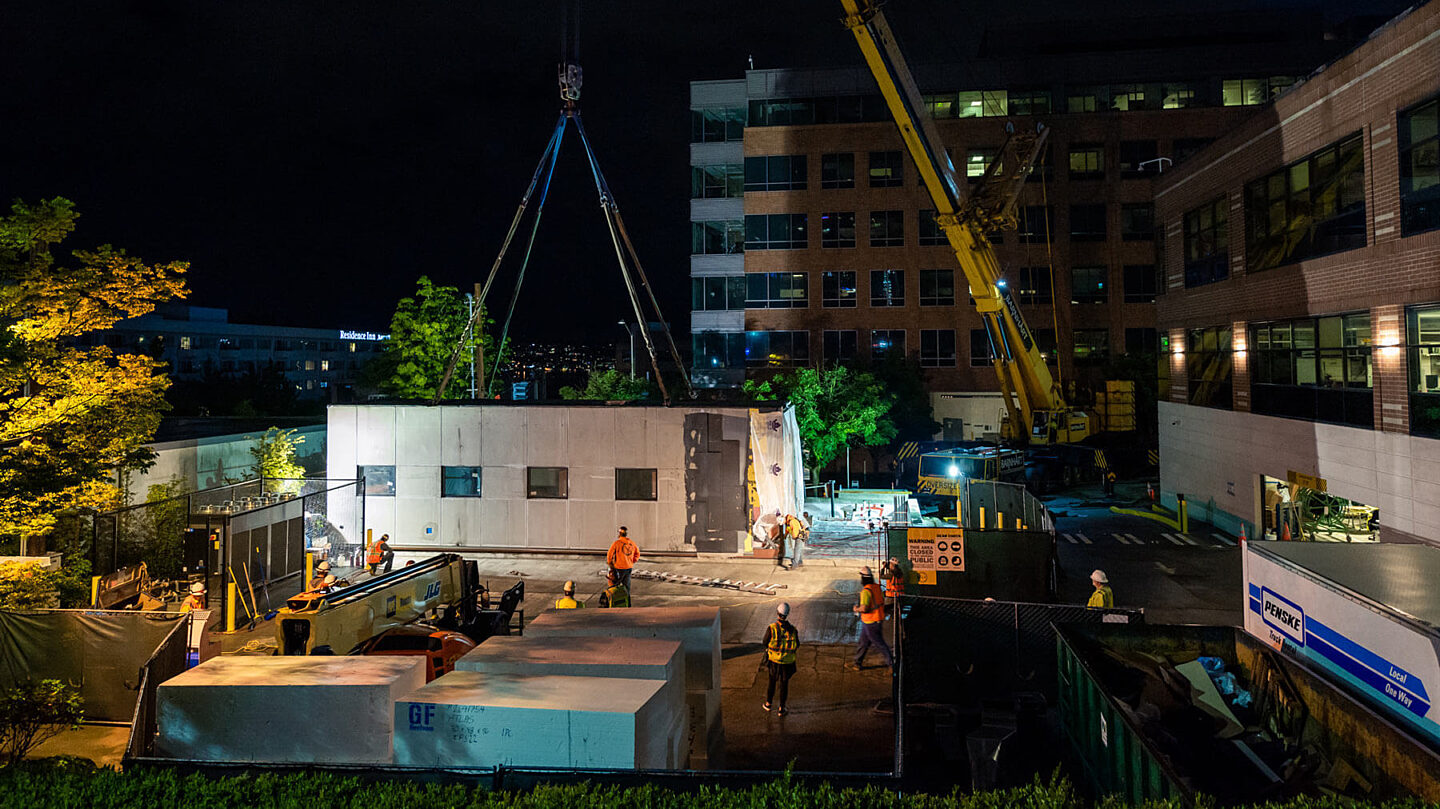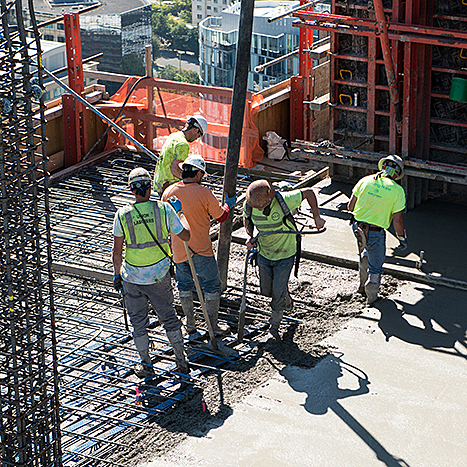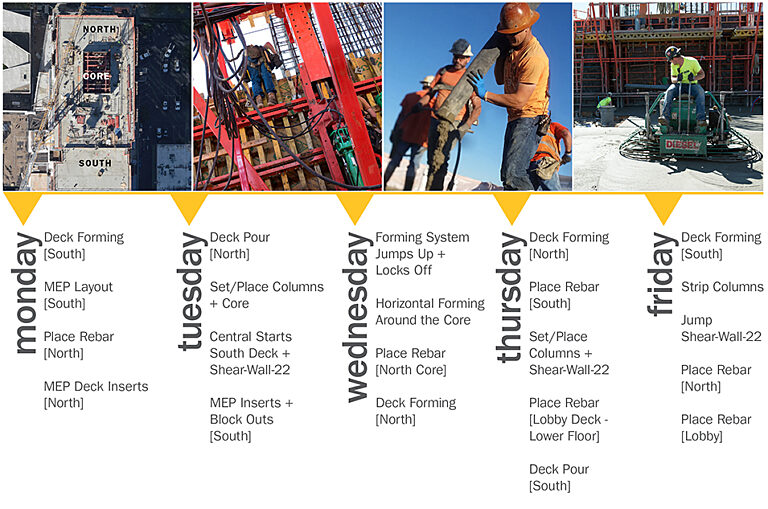Lean

Insights 11.16.2021
Key Considerations for Complete Modular Buildings
Once a buzzword and only a possibility, prefabrication [or prefab] is now common practice on most construction projects.

Josh Lewis
Senior Project Manager


As highrises become increasingly present on our horizon, built for clients looking for faster and faster delivery, we challenge ourselves to find room for improvement in our daily processes. The Lincoln Square Expansion North Tower—a hotel and residential hi-rise in downtown Bellevue—provided the perfect opportunity to tackle and perfect a feat that we hope to offer on future projects with similar conditions. What began as making up a lost day in a six-day concrete pour turned into refusing to accept status quo. If a team can complete a six-day pour in five days one time, why not make it the new norm?
Aside from the obvious craftpersons’ perspective—freeing up Saturdays to enjoy much-needed time off—pouring a deck in five days instead of the standard six equals a faster turnover. For any owner looking to lease apartments or office space, this is music to their ears: faster turnover = lease sooner = more revenue.
Shaving one day off a specific scope of work doesn’t sound like much when you think of how long it takes to construct a high-rise, but for a 42-story cast-in-place concrete building where one floor is poured each week, one day per week adds up to over one month’s cost savings in manpower and equipment. It also buys back time in the schedule to make up for unexpected delays. At best, a successful five-day pour can deliver a project one month ahead, and put an extra month of lease revenue in the owner’s pocket. And also make for a happy, well-rested crew!
In highrise construction, all subsequent work relies on the completion of each level. The quicker the concrete is poured, the quicker the curtain wall and the interiors can start.
Common sense, right? So why isn’t a five-day pour standard practice? Because it’s not easy. It takes a proactive, well-organized Superintendent, a high level of collaboration and buy-in from subcontractors, and top notch strategic planning and scheduling.

Lincoln Square Expansion North Tower climbs to 42 stories.
Although the six-day work cycle was working well on the Lincoln Square Expansion North Tower, especially on the larger decks for Levels 1-4, it was tough on the crew that was giving up Saturdays to work overtime. It often takes an unanticipated obstacle to help us discover a better path and this is precisely what happened after a crane shut-down on a record-setting windy day in March when the crew was scheduled to pour level L-15.
The crew urgently needed to make up the lost time and Superintendent Reed McNulty was tasked with increasing the crew’s efficiency. Reflecting on the impact the crane shut-down imposed on the schedule, Reed realized that the instrument of their misfortune could just as easily be turned into the means of their recovery. The whole schedule is determined by how quickly the materials can be hoisted up to the deck. So finding a more efficient way to deliver the materials would have an immediate positive impact on making up for lost time.
Reed took a hard look at the crane schedule, breaking it down into 30-minute increments. Once he found openings and room for movement in hoisting, he considered the other activities. When are the crews on the deck tying rebar, setting column forms, MEP rough in, setting embeds?
After finding gaps where he could cut out down time and reorganizing activities to increase synergies, he invited Steve Murry from McClone [horizontal deck subcontractor] and Tony Gerde from Central Steel [steel supplier] to take a look. Together they realized that if everyone bought in to the faster schedule, they could make up the lost day.
Now at L-15 with 27 levels of concrete deck to go above them, Reed thought that if GLY could do a deck pour in five days once, why not do it 27 more times?
Committing to the reduced schedule for the next six months wasn’t as easy as committing to it for just one week. Without the pressure to make up downtime, would the team be as motivated to cut down the pour to five days week after week? Committing to 27 more accelerated pours was daunting. Undeterred, Reed brought the entire deck team to the table [Central Steel, McClone, Nelson Electric, MM and Patriot] to look at the schedule line by line.
Securing the buy-in of McClone and Central Steel was again critical to committing to the expedited schedule. Each team member’s commitment depended on another’s. If GLY committed to forming walls during McClone’s deck forming cycle, and set and placed columns on the same day, then McClone had to commit to framing horizontal decks in two days instead of three. Central agreed to start with rebar before McClone completed the edge form. They also agreed to allow MEP layout to overlap the beginning and end of their two days on deck. This meant that Central’s allocated time remained the same, but other activities were taking place simultaneously. Everyone agreed the new schedule was possible but, pragmatically, wanted to test it for a couple of weeks to make sure it wasn’t more trouble than it was worth.

Nearing completion of the deck pours on the North Tower.

Looking West towards the Lincoln Square Expansion North Tower.
With McClone and Central on board, Reed approached the remaining subcontractor teams. Each subcontractor’s start-date relied on the completion of another subcontractor’s scope of work, so Reed needed 100% buy-in. The rebar truck had to be at the site at 7:30 a.m., post-tension tendons needed to be up on deck at 1:00 p.m….timing was everything. In the end, having six months of Saturdays given back turned out to be a powerful thing. With the prospect of a day spent with family and friends instead of in the rain and wind on the jobsite, every team member was quickly convinced.
From that point forward, it took only two weeks to clear a few remaining logistical hurdles, and by Level 18, the crew had a smooth five-day cycle nailed down. Overall, 24 days were cut from the schedule. This also resulted in reduced overtime for the crew, and cost savings for the project due to less equipment and manpower in use on a weekend.
On the other hand, this new pour cycle also gives the option to offer a client faster delivery. Building back-to-back five-day pours into the entire project schedule from day one, [i.e. start Monday, finish Friday, and start the next cycle on Saturday] creates an opportunity to shave weeks, even months off the schedule. As GLY moves forward, we’re well-equipped to offer schedule options with confidence. Faster delivery? You bet.
For those who like granular detail like we do, here’s a breakdown of day-to-day activities in a five-day pour:


Superintendent
Ever wonder if a Superintendent gets tired of scheduling? Just ask Reed! After more than 37 years in the industry, he still loves solving each new puzzle. A GLY veteran with a deep resume, he’s done it all from high-tech office buildings to heavy site civil work—mentoring up-and-coming field supervisors along the way. Outside the jobsite, he works on his collection of muscle cars and unwinds in the outdoors with fishing and hunting.